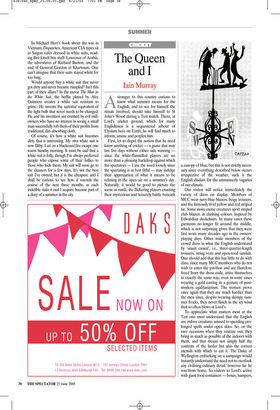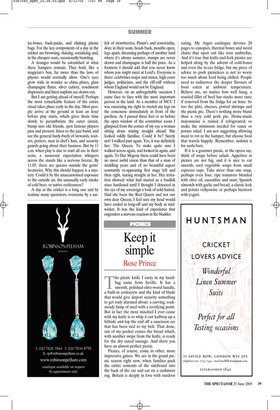The Queen and I
Iain Murray
Astranger to this country curious to know what summer means for the English, and to see for himself the rituals involved, should take himself to St John’s Wood during a Test match. There, at Lord’s cricket ground, which for many Englishmen is a sequestered arbour of Elysium here on Earth, he will find much to inform, amuse and perplex him.
First, let us dispel the notion that he need know anything of cricket — a game that may last five days without either side winning since the white-flannelled players are no more than a pleasing backdrop against which the spectators — I use the word loosely since the spectating is at best fitful — may indulge their appreciation of what it means to be relaxing in the open air on a summer’s day. Naturally, it would be good to picture the scene as sunlit, the flickering players enacting their mysterious and leisurely battle beneath a canopy of blue, but this is not strictly necessary since everything described below occurs irrespective of the weather, such is the English disdain for the unmannerly vagaries of our climate.
Our visitor will notice immediately the variety of dress on display. Members of MCC wear navy-blue blazers, beige trousers, and the famously livid yellow and red striped tie. Some more exotic creatures sport striped club blazers in clashing colours inspired by Edwardian deckchairs. In many cases these garments no longer fit around the middle, which is not surprising given that they were first worn many decades ago in the owners’ playing days. Other male members of the crowd dress in what the English understand by ‘smart casual’, i.e., three-quarter-length trousers, string vests and open-toed sandals. One should add that this has little to do with class, since many MCC members who do not wish to enter the pavilion and are therefore freed from the dress code, attire themselves in exactly the same way, even in some cases wearing a gold earring in a gesture of postmodern egalitarianism. The women prove once again that they are much hardier than the men since, despite wearing skimpy summer frocks, they never flinch in the icy wind that so often blows at Lord’s.
To appreciate what matters most at the Test one must understand that the English are indoor creatures unused to spending prolonged spells under open skies. So, on the rare occasions when they venture out, they bring as much as possible of the indoors with them, and that means not simply half the contents of the larder but also the correct utensils with which to eat it. The Duke of Wellington embarking on a campaign would instantly understand the need not to overlook any civilising culinary detail, however far he was from home. So visitors to Lord’s arrive with giant food containers — boxes, hampers, ice-boxes, back-packs, and clinking plastic bags. For the key components of a day at the cricket are browsing, sluicing, socialising and, in the cheaper seats, occasionally brawling.
A stranger would be astonished at what these hampers contain. They hold, like a magician’s box, far more than the laws of physics would normally allow. One’s eyes grow wide in wonder as china plates, glass champagne flutes, silver cutlery, condiment dispensers and linen napkins are drawn out.
But I am getting ahead of myself. Perhaps the most remarkable feature of the entire ritual takes place early in the day. Most people arrive at the ground at least an hour before play starts, which gives them time slowly to perambulate the outer circuit, bump into old friends, spot famous players past and present, listen to the jazz band, and see the general hurly-burly of stewards, waiters, porters, men in chef’s hats, and security guards going about their business. But by 11 a.m. when play is due to start all are in their seats, a susurrant expectation whispers across the stands like a nervous breeze. By 11.05, there are queues outside the gents’ lavatories. Why this should happen is a mystery. Could it be the unaccustomed exposure to the outside air, the unusually early intake of cold beer, or native restlessness?
A day at the cricket is a long one and by teatime many spectators, overcome by a sur feit of strawberries, Pimm’s and conviviality, doze in their seats, heads back, mouths open, legs apart, dreaming perhaps of another land where it’s always summer, stumps are never drawn and champagne is half the price. As a footnote I should add that you never know whom you might meet at Lord’s. Everyone is there: celebrities major and minor, high court judges, politicians, and the riff-raff without whom England would not be England.
However, on an unforgettable occasion I came face to face with the most important person in the land. As a member of MCC I was exercising my right to stretch my legs on the concourse immediately in front of the pavilion. As I passed three feet or so before the open window of the committee room I glimpsed from the corner of my eye a woman sitting alone staring straight ahead. She looked oddly familiar. Could it be? Surely not! I walked past again. Yes, it was definitely her. The Queen. To make quite sure I walked across again, and looked in again, and again. To Her Majesty there could have been no more awful vision than that of a man of middling years and of no beautiful aspect constantly re-appearing first stage left and then right, staring straight at her. Her irritation showed: what had started as a basilisk stare hardened until I thought I detected in the eye of my sovereign a look of cold hatred. Had she been the Red Queen and not our own dear Queen, I feel sure my head would have ended at long-off and my body at midwicket. It was the kind of experience that engenders a nervous reaction in the bladder.



































































 Previous page
Previous page